
The Berlin Wall was a guarded concrete barrier that encircled West Berlin from 1961 to 1989, separating it from East Berlin and the German Democratic Republic. Construction of the Berlin Wall was commenced by the government of the GDR on 13 August 1961. It included guard towers placed along large concrete walls, accompanied by a wide area that contained anti-vehicle trenches, beds of nails and other defenses. The primary intention for the Wall's construction was to prevent East German citizens from fleeing to the West.

West Berlin was a political enclave which comprised the western part of Berlin from 1948 until 1990, during the Cold War. Although West Berlin lacked any sovereignty and was under military occupation until German reunification in 1990, the territory was claimed by the Federal Republic of Germany, despite being entirely surrounded by the German Democratic Republic. The legality of this claim was contested by the Soviet Union and other Eastern Bloc countries. However, West Berlin de facto aligned itself politically with the FRG from May 1949 and was thereafter treated as a de facto city-state of that country. After 1949, it was directly or indirectly represented in the institutions of the FRG, and most of its residents were citizens of the FRG.

Günter Schabowski was a German politician who served as an official of the Socialist Unity Party of Germany, the ruling party during most of the existence of East Germany. After climbing up the party ladder, he became the regime's unofficial spokesman. He gained worldwide fame in November 1989 when he improvised a slightly mistaken answer to a press conference question about the future of the Berlin Wall, that seemed to announce the Wall's immediate end and raised popular expectations much more rapidly than the government planned. Massive crowds gathered at the Wall the same night, which forced its opening after 28 years. Soon afterward, the entire inner German border was opened; not much later, East Germany ceased to exist.

Spandau is the westernmost of the 12 boroughs of Berlin, situated at the confluence of the Havel and Spree rivers and extending along the western bank of the Havel. It is the smallest borough by population, but the fourth largest by land area.
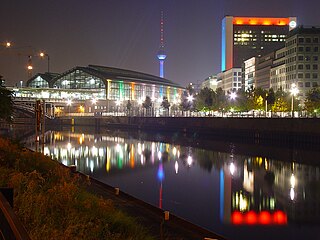
The Berlin S-Bahn is a rapid transit railway system in and around Berlin, the capital city of Germany. It has been in operation under this name since December 1930, having been previously called the special tariff area Berliner Stadt-, Ring- und Vorortbahnen. It complements the Berlin U-Bahn and is the link to many outer-Berlin areas, such as Berlin Brandenburg Airport. As such, the Berlin S-Bahn blends elements of a commuter rail service and a rapid transit system.
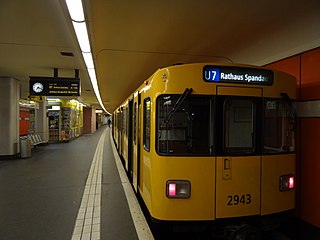
The U7 is a rail line on the Berlin U-Bahn. It runs completely underground for a length of 31.8 kilometres (19.8 mi) through 40 stations and connects Spandau, via Neukölln, to Gropiusstadt and Rudow. The U7 was originally the south-eastern branch of the Nord-Süd-Bahn (U6) that ran between the branching point at Belle-Alliance-Straße (Mehringdamm) and Grenzallee; however, in the 1960s, this stretch was separated from the rest of the line and extended at each end to form a new line.
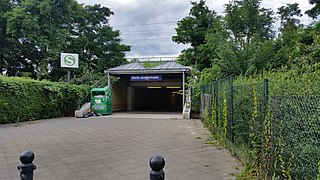
Berlin Jungfernheide is a railway station located at Charlottenburg-Nord, in the Charlottenburg-Wilmersdorf district of Berlin, served by the S-Bahn lines S41 and S42, the U-Bahn line U7 and Regional-Express trains of the Deutsche Bahn. Its name literally translates into "maidens' heathland"; it was named after the Jungfernheide, a former large forest in the proximity of this station.
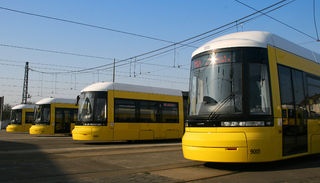
The Berlin tramway is the main tram system in Berlin, Germany. It is one of the oldest tram networks in the world having its origins in 1865 and is operated by Berliner Verkehrsbetriebe (BVG), which was founded in 1929. It is notable for being the third-largest tram system in the world, after Melbourne and St. Petersburg. Berlin's tram system is made up of 22 lines that operate across a standard gauge network, with almost 800 stops and measuring almost 190 kilometres (120 mi) in route length and 430 kilometres (270 mi) in line length. Nine of the lines, called Metrotram, operate 24 hours a day and are identified with the letter "M" before their number; the other thirteen lines are regular city tram lines and are identified by just a line number.
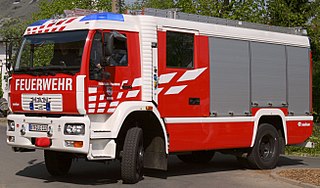
The Feuerwehr is a number of German fire departments. The responsible bodies for operating and equipping fire departments are the German communities ("Gemeinden") and cities ("Städte"). By law, they are required to operate fire-fighting forces. In cities, this is usually performed by the Fire Prevention Bureau, one of the higher-ranking authorities.
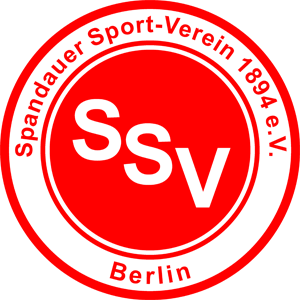
Spandauer SV was a German football club from Berlin.

Berlin-Spandau station is a Deutsche Bahn station in the Berlin district of Spandau on the south-western edge of the old town of Spandau. The railway junction station is one of the 80 stations classified by Deutsche Bahn as a category 2 station. It has the longest train shed in Germany.

Spandau is a locality (Ortsteil) of Berlin, Germany's capital and largest city, in the homonymous borough (Bezirk) of Spandau. The historic city is situated, for the most part, on the western banks of the river Havel. As of 2020, the estimated population of Spandau was 39,653.
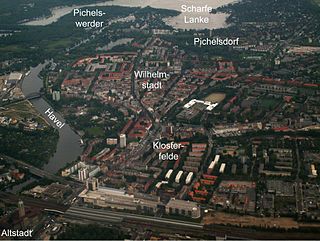
Wilhelmstadt is a German locality (Ortsteil) of Berlin in the borough (Bezirk) of Spandau.

The Bundeswehrfeuerwehr is a fire fighting department of Bundeswehr, the armed forces of Germany. With over 3,000 employees, it is the second largest professional fire department in Germany.
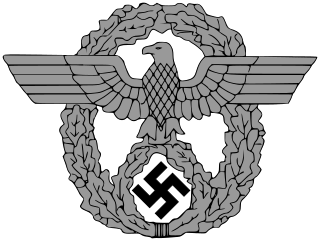
Feuerschutzpolizei was a fire police unit in Nazi Germany and a branch of Nazi Germany's Ordnungspolizei, formed in 1938 when the German municipal professional fire brigades were transferred to the national police. The previously red fire vehicles, blue uniforms and fire service ranks were replaced by green fire vehicles, green uniforms and police ranks.

The Magirus-Deutz Muni is a fire-fighting vehicle from Germany, which was produced by the Ulmer commercial vehicle manufacturer Magirus-Deutz in only 6 pieces.

St. Marien am Behnitz is the second-oldest Catholic church in the area of Berlin, Germany, after St. Hedwig's Cathedral. It was built in Spandau on a design by August Soller, and consecrated in 1848. Restored in 2002–2003 by private owners, it is a registered monument, used mostly for musical and literary events.

Kai Wegner is a German politician of the Christian Democratic Union (CDU) who has been serving as Governing Mayor of Berlin since April 2023. He served as a member of the Bundestag, the German federal parliament, from 2005 to 2021. In 2019, he became the chairman of the CDU in Berlin.

The Berlin Fire Brigade is the fire and emergency medical service for Berlin, Germany. As well as firefighting, the Berlin Fire Brigade provides fire prevention, technical rescue services, emergency medical services, and assistance in case of chemical, biological, radioactive and nuclear hazards.

The Electric Tramway Spandau-Nonnendamm GmbH (SpN) – colloquially known as Nonnendammbahn – was a tramway company that operated between 1909 and 1914, originating from a tram line established by Siemens & Halske in 1908. Three months after its founding, the then-independent city of Spandau acquired all shares in the railway, and its operations were taken over by the Municipal Tramway of Spandau the following year. With the deletion of Nonnendammbahn from the commercial register in 1914, it was fully integrated into the Spandau tramway.



















